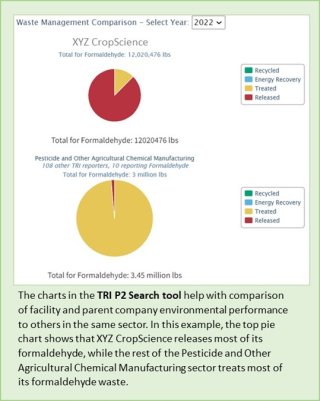TRI for Industry
Many companies use chemicals in their processes and engage in pollution prevention (P2) activities. If companies meet TRI reporting requirements, they must submit chemical reporting form(s) to EPA with details about quantities and methods used to manage and prevent waste. Companies and industrial associations can use the submitted data for numerous purposes.
How can companies use TRI data?
TRI tracks the management of certain toxic chemicals that may pose a threat to human health and the environment from TRI-reporting industrial facilities. TRI tools allow for online exploration or download of all reported data and summarizes information for different geographies (e.g., ZIP code, city, state), chemicals, industries and facilities.
Companies can use TRI data to:
- Learn what toxic chemicals facilities use and release into the environment.
- Assess and track changes in chemical waste management trends and industry sector performance.
- Evaluate industry progress in improving environmental performance (e.g., sustainability reports and projects).
- Help identify P2 opportunities at facilities and across the supply chain.
- Compare and learn what facilities are doing.
- Promote best practices on chemical waste source reduction activities.
Spotlight: Xerox Uses TRI Data
In its 2023 corporate social responsibility report, Xerox cited its reported TRI data in its evaluation of the company’s global waste management practices. Read the full report.
Spotlight: Highlighting P2 Success Stories
EPA often highlights the P2 accomplishments of specific facilities to encourage other facilities to report optional P2 information and to learn from existing best practices, particularly those in the same industry sector. One such ‘P2 Spotlight’ focuses on reductions of metal waste by automobile, aerospace, and metal fabrication facilities from 2007 to 2018. Read the full spotlight.
How do facilities compare to each other?

Companies can use the TRI P2 Search Tool to learn how the waste management and pollution prevention activities at one facility compare to others in the same industry sector.
Use other TRI tools for more ways to visualize or download data. These tools can help you find information about a specific facility or chemical, industry sector, geographic location, or potential health-related impacts, displayed in different formats.
Want to learn more about pollution prevention opportunities?
Implementing pollution prevention activities can strengthen facility finances, protect the surrounding community and environment, and improve public perceptions of a facility.
Facilities reporting to TRI have provided information about source reduction activities implemented since 1991. Additionally, facilities may report on barriers to implementing pollution prevention activities. P2 activity data are available as a resource for analysis as well as to provide insight on how other facilities have transitioned towards safer solutions. In addition to the tools noted above, there is easy access to solvent substitutions information reported to TRI.
Additional Information
- TRI Program Regional Coordinators: Contact the TRI Coordinator in your region for more information on data use and pollution prevention strategies.
- EPA Smart Sectors Program: EPA’s Smart Sectors Program provides a platform to collaborate with industry sectors and develop creative solutions that better protect the environment and public health.
- EPA P2 Program: Learn more about EPA's P2 Program and contact Regional P2 Coordinators to arrange a free, confidential P2 assessment with a third-party P2 expert.
- P2 and TRI: Learn more about the benefits of pollution prevention and about TRI’s P2 data.

